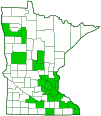Wrinkled Peach
(Rhodotus palmatus)
Conservation • Description • Habitat • Ecology • Distribution • Taxonomy
Conservation Status |
|||
| IUCN Red List | not listed |
||
| NatureServe | not listed |
||
| Minnesota | not listed |
||
Description |
Wrinkled Peach is a small to medium-sized, easily recognized but infrequently found gill mushroom. It is found scattered or in small groups on fallen, rotting hardwoods, especially on elm but occasionally also on basswood and maple. It is saprobic, getting its nutrients from well-decayed wood. The stalk (stipe) is 1¼″to The cap is The flesh is pinkish, firm, and rubbery. It is considered inedible due to its bitter taste, but at least one source (Roger’s Mushrooms) lists the taste as mild. The gills are thick, closely spaced, and broadly attached to the stipe. They are similar in color to, but slightly paler than, the cap. The spore print is pinkish. |
Similar Species |
No similar species. The lightly-colored netted surface, when present, is distinctive. |
Habitat and Hosts |
Dead deciduous wood, especially maple and elm |
Ecology |
Season |
June through September |
Distribution |
||
|
Sources Biodiversity occurrence data published by: Minnesota Biodiversity Atlas (accessed through the Minnesota Biodiversity Atlas Portal, bellatlas.umn.edu, 9/7/2025). |
|
| 9/7/2025 | ||
Occurrence |
||
Infrequent |
||
Taxonomy |
|
Kingdom |
Fungi (Fungi) |
Subkingdom |
Dikarya |
Phylum |
Basidiomycota (Basidiomycete Fungi) |
Subphylum |
Agaricomycotina (Higher Basidiomycetes) |
Class |
Agaricomycetes (Mushrooms, Bracket Fungi, Puffballs, and Allies) |
Subclass |
Agaricomycetidae |
Order |
|
Suborder |
Marasmiineae |
Family |
Physalacriaceae |
Genus |
Rhodotus |
Subordinate Taxa |
|
|
|
Synonyms |
|
Agaricus palmatus Agaricus palmatus var. palmatus Agaricus palmatus var. sessilis Agaricus phlebophorus var. reticulatus Agaricus subpalmatus Crepidotus palmatus Dendrosarcus subpalmatus Entoloma cookei Gyrophila palmata Pleuropus palmatus Pleurotus palmatus Pleurotus subpalmatus Rhodotus subpalmatus |
|
Common Names |
|
Netted Rhodotus Rosy Veincap Wrinkled Peach |
|
Glossary
Pellicle
A thin, outer, gelatinous membrane on the surface of the cap of a mushroom.
Saprobic
A term often used for saprotrophic fungi. Referring to fungi that obtain their nutrients from decayed organic matter.
Stipe
A supporting stalk-like structure lacking vascular tissue: in fungi, the stalk supporting the mushroom cap; in ferns, the stalk connecting the blade to the rhizome; in flowering plants, the stalk connecting the flower’s ovary to the receptacle; in orchids; the band connecting the pollina with the viscidium.
Universal veil
An egg-like structure that envelopes all or most of a developing gill mushroom. Remnants of the universal veil sometimes visible on a mature mushroom are patchy warts on the cap, a ring on the stalk, and a volva at the base of the stalk.
Increasing
Before the middle of the twentieth century this mushroom was rare in North America. With the advance of Dutch elm disease, the number of dead elms has greatly increased, as has the population of this mushroom.
Visitor Photos |
Share your photo of this fungus. |
||
This button not working for you? |
||
Katey |
 |
DBaloi |
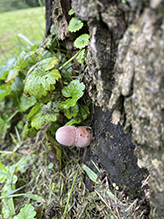 |
on decaying stump |
Stephanie Segner |
||
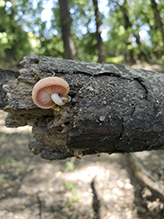 |
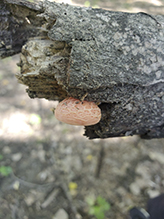 |
|
Jacquelin Boekhoff |
||
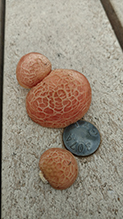 |
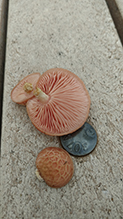 |
|
MinnesotaSeasons.com Photos |
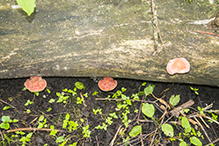 |
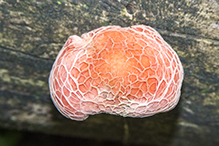 |
|
 |
 |

Slideshows
Rhodotus palmatus - fungi kingdom
Nineli Lishina

Visitor Videos
Share your video of this fungus.
This button not working for you?
Simply email us at info@MinnesotaSeasons.com.
Attach a video, a YouTube link, or a cloud storage link.
Other Videos
2010 Rhodotus Palmatus Madrid AMTA
Miguel Rodriguez
Rhodotus Palmatus
László Kaposvári

Visitor Sightings |
Report a sighting of this fungus. |
||
This button not working for you? |
||
rachelplaetz
6/2/2018
Location: Beaver Falls Township
MinnesotaSeasons.com Sightings |

